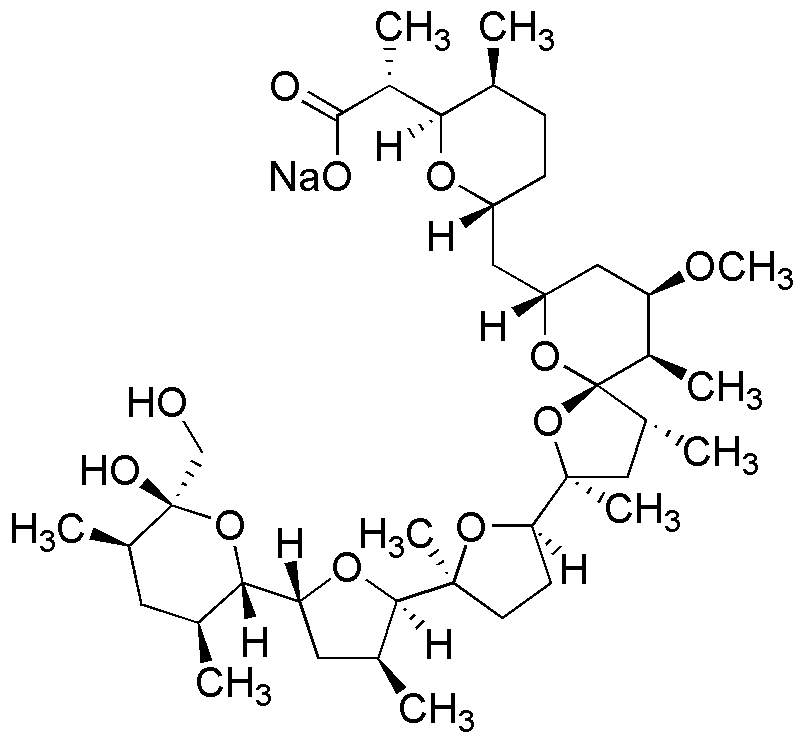Nigericin sodium salt (from Streptomyces hygroscopicus) is widely utilized in research focused on:
- Cell Biology: This compound is often used as a potassium ionophore, facilitating the study of ion transport mechanisms across cell membranes. Researchers can investigate cellular responses to changes in ion concentrations, which is crucial for understanding various physiological processes.
- Pharmacology: Nigericin sodium salt is valuable in drug development, particularly in evaluating the effects of ionophores on drug delivery systems. Its ability to alter membrane permeability can enhance the efficacy of certain therapeutic agents.
- Microbiology: In microbiological studies, this compound aids in the examination of microbial metabolism and growth conditions. It can be used to manipulate ion concentrations in culture media, providing insights into microbial behavior under different environmental stresses.
- Neuroscience: The compound is utilized in neurophysiological research to study the role of potassium ions in neuronal excitability and signaling. This application helps in understanding neurological disorders and developing potential treatments.
- Biochemistry: Nigericin sodium salt is employed in enzyme assays and biochemical pathways analysis, allowing researchers to explore enzyme kinetics and the impact of ion transport on metabolic processes.
General Information
Properties
Safety and Regulations
Applications
Nigericin sodium salt (from Streptomyces hygroscopicus) is widely utilized in research focused on:
- Cell Biology: This compound is often used as a potassium ionophore, facilitating the study of ion transport mechanisms across cell membranes. Researchers can investigate cellular responses to changes in ion concentrations, which is crucial for understanding various physiological processes.
- Pharmacology: Nigericin sodium salt is valuable in drug development, particularly in evaluating the effects of ionophores on drug delivery systems. Its ability to alter membrane permeability can enhance the efficacy of certain therapeutic agents.
- Microbiology: In microbiological studies, this compound aids in the examination of microbial metabolism and growth conditions. It can be used to manipulate ion concentrations in culture media, providing insights into microbial behavior under different environmental stresses.
- Neuroscience: The compound is utilized in neurophysiological research to study the role of potassium ions in neuronal excitability and signaling. This application helps in understanding neurological disorders and developing potential treatments.
- Biochemistry: Nigericin sodium salt is employed in enzyme assays and biochemical pathways analysis, allowing researchers to explore enzyme kinetics and the impact of ion transport on metabolic processes.
Documents
Safety Data Sheets (SDS)
The SDS provides comprehensive safety information on handling, storage, and disposal of the product.
Product Specification (PS)
The PS provides a comprehensive breakdown of the product’s properties, including chemical composition, physical state, purity, and storage requirements. It also details acceptable quality ranges and the product's intended applications.
Certificates of Analysis (COA)
Search for Certificates of Analysis (COA) by entering the products Lot Number. Lot and Batch Numbers can be found on a product’s label following the words ‘Lot’ or ‘Batch’.
*Catalog Number
*Lot Number
Certificates Of Origin (COO)
This COO confirms the country where the product was manufactured, and also details the materials and components used in it and whether it is derived from natural, synthetic, or other specific sources. This certificate may be required for customs, trade, and regulatory compliance.
*Catalog Number
*Lot Number
Safety Data Sheets (SDS)
The SDS provides comprehensive safety information on handling, storage, and disposal of the product.
DownloadProduct Specification (PS)
The PS provides a comprehensive breakdown of the product’s properties, including chemical composition, physical state, purity, and storage requirements. It also details acceptable quality ranges and the product's intended applications.
DownloadCertificates of Analysis (COA)
Search for Certificates of Analysis (COA) by entering the products Lot Number. Lot and Batch Numbers can be found on a product’s label following the words ‘Lot’ or ‘Batch’.
*Catalog Number
*Lot Number
Certificates Of Origin (COO)
This COO confirms the country where the product was manufactured, and also details the materials and components used in it and whether it is derived from natural, synthetic, or other specific sources. This certificate may be required for customs, trade, and regulatory compliance.


